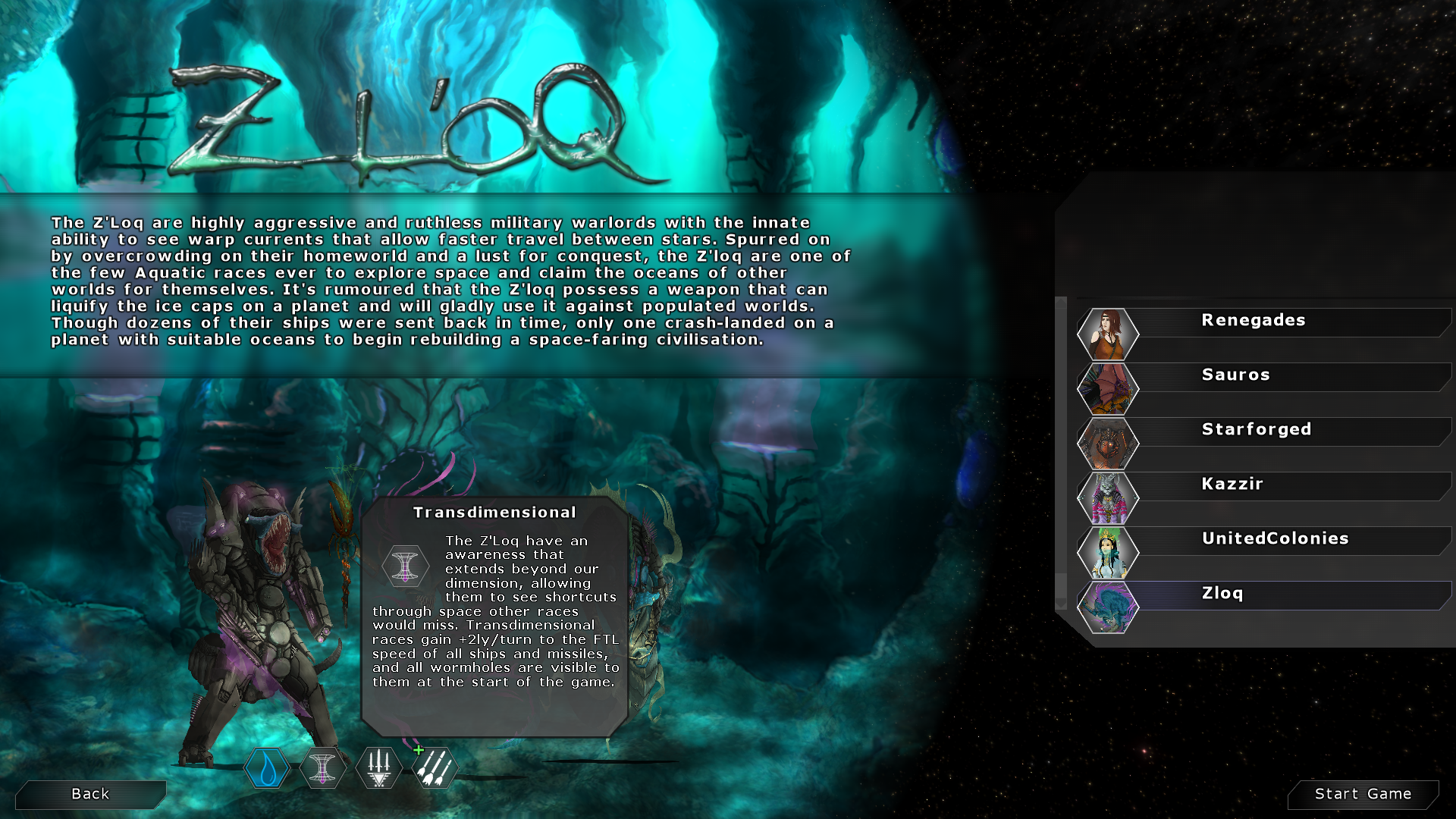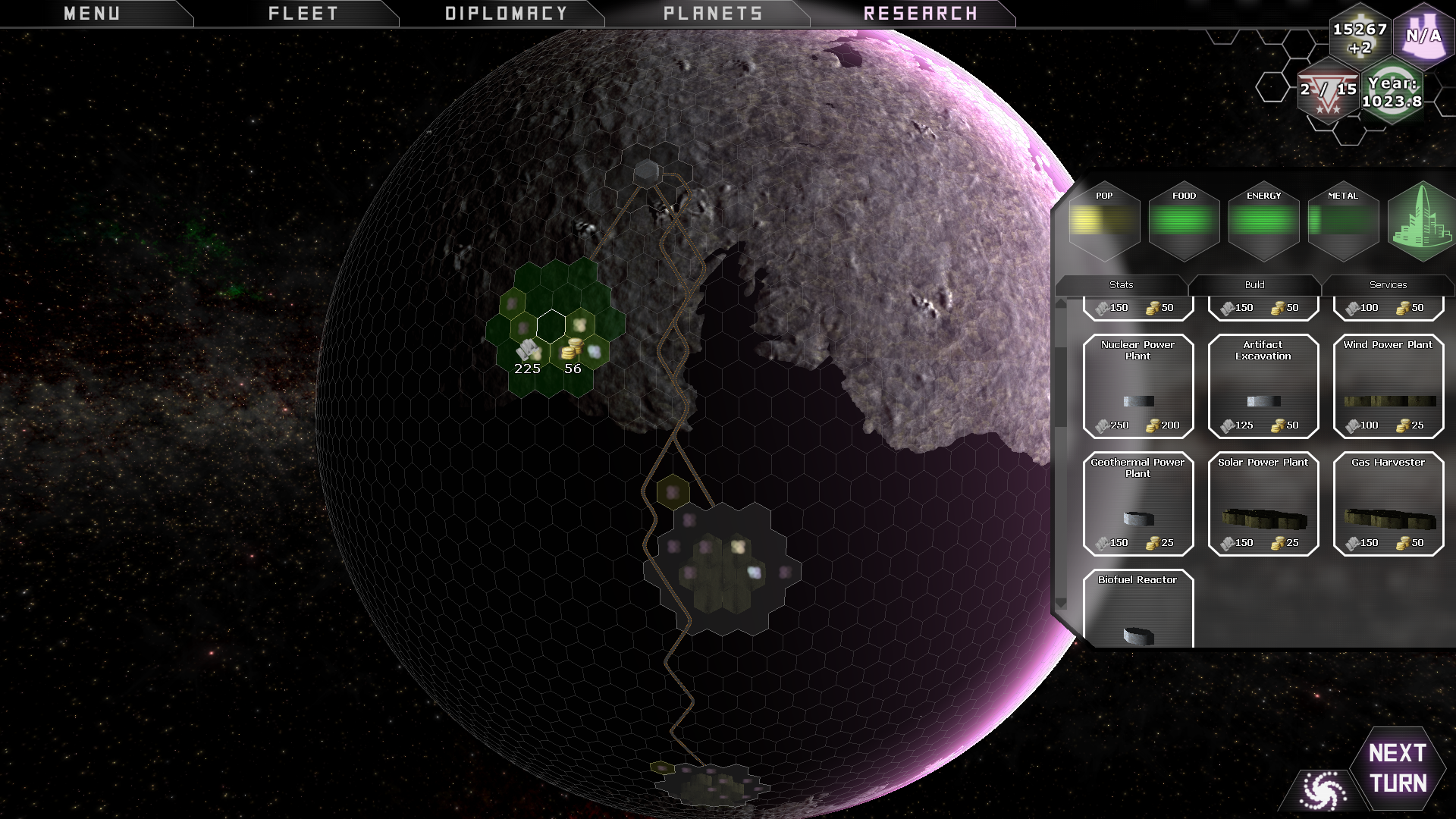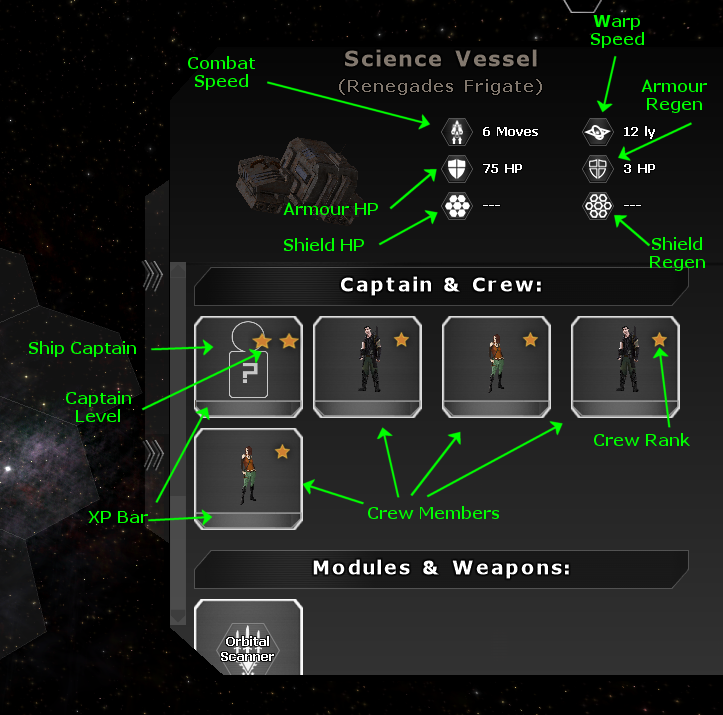 This is going to be a colossal dev update, as we’ve been pushing out patches at a much faster pace since the release of the 3D ship designer. In this dev update, I’ll round up all the work that’s been deployed in the last month and a bit, from the deployment of Race Archetypes and Race Stats to the release of Ship Captains and Planet Leaders, and the most recent Tax system update. Then I’ll look briefly at the next steps for Predestination and what you can expect from future patches.
This is going to be a colossal dev update, as we’ve been pushing out patches at a much faster pace since the release of the 3D ship designer. In this dev update, I’ll round up all the work that’s been deployed in the last month and a bit, from the deployment of Race Archetypes and Race Stats to the release of Ship Captains and Planet Leaders, and the most recent Tax system update. Then I’ll look briefly at the next steps for Predestination and what you can expect from future patches.
 Race archetypes:
Race archetypes:
Each of the four race archetypes (Humanoid, Reptilian, Aquatic and Robotic) now has its own specific version of the tech trees with a few technologies swapped for race-specific ones that are marked in green. Each archetype also has slightly different planetary gameplay, and race-specific buildings and infrastructure. We made sure each race archetype has a particular preferred environment not just because of an arbitrary limitation but because planets work well with their unique racial stuff. Robotic races can only build ByteCoin Miners to make money in Ice environments, Aquatic races need lots of ocean area to build their infrastructure in, and Reptiles need desert environments for their farms to work.
- Aquatic – Aquatic races start out on Ocean planets and most of their infrastructure is limited to Ocean environments. Their core mechanic is that they can plant Coral Reefs which grow resources over time. The Metallic Coral Reef generates metal and grows deposits of coral over time, while the Fishing Coral Reef generates food and grows clusters of fish over time. The reefs take up a lot of space but don’t require existing resources to be exploited, so the Aquatic races fare best on planets with large oceans. If the reefs are ever destroyed, the deposits they grew are instantly destroyed. Unique technologies include upgrades for the reefs.
- Reptilian – Reptilian races start out on Desert planets and have access to standard starting infrastructure such as the ore refinery and fossil fuel power plant. They have a Desert Farm instead of a standard farm, which only generates food on Desert terrain hexes. Their core mechanic is that each city contains a central Hatchery building that grows population and gives global bonuses across the whole planet, so you can stack the bonus from multiple cities together to create more specialised planets. Unique technologies for Reptilian races include different Hatcheries and techs relating to slave labour.
- Robotic – Robotic races start on Ice planets and consume Energy Cells instead of food, which are produced in the Robot Charging Station infrastructure. The planets of Robotic races always have 100% Health and Morale ratings, but robotic population don’t generate tax. Instead, they generate money directly through an infrastructure called the ByteCoin Miner. Robots also don’t have population growth, but build new population manually at a cost of 1000 BC and 4000 energy cells for 1000 population. Robotic races are all about directly managing all resources rather than things growing or changing over time. Rather than being tied to an environment for food production, they are tied to the Ice environment by finances because the ByteCoin miner must be built in an Ice environment. Unique technologies for robotic races include distributed computing techs, upgrades to the Forge building, and antivirus and networking buildings for security etc.
- Humanoid – Humanoid races start out on Terran planets and have access to standard starting infrastructure such as the ore refinery and fossil fuel power plant. Humanoid farms can only produce food from terran hexes on a planet, and can only natively use the Terran environments on their starting planet until they get biosphere technology. Humanoids don’t have a special core mechnic but function just as the game has always played, and they have the standard set of technologies.
 Race traits:
Race traits:
In addition to bonuses to stats such as metal production or beam weapon damage, a number of unique race traits have been added to make the races of the game really differentiate from each other and have a more unique play style:
- Internal Combustion: Robotic races have the optional trait of Internal Combustion, which means they consume fossil fuels instead of Energy Cells. They produce Fuel Pellets in the Fossil Fuel Pellet Factory infrastructure, and gain access to a Nuclear version in their tech tree. (The Starforged have this trait)
- Hardy: Humanoid races have the optional Hardy trait, which makes them easily adapt to Ice and Desert environments. They will no longer require infrastructure or city biospheres in these environments, which saves you money each turn in upkeep costs. (The Renegades have this trait)
- Creative: At any point where the technology trees split into multiple options, normally you can only research one of the choices and the others will be locked, making them obtainable only from diplomatic trade with other races or random tech discovery events (not yet implemented). Creative races don’t have this limitation, so they can go back and research multiple paths through the tech tree. (The United Colonies have this trait)
- Trans-Dimensional: Some races have a perception that goes beyond the standard three dimensions, enabling them to see warp currents and shortcuts through space. Races with this trait gain +2 lightyear per turn warp speed of all fleets and can see all wormholes at the start of the game. (The Z’loq have this trait)
- Escort Ships: Though mostly small individual ships survived the transition through the temporal rift from the future, races with this trait were lucky enough to have companion ships that also crashed on the planet. They start the game with two crashed ship deposits next to their city to be excavated, giving a huge boost in initial research. (The Sauros have this trait, though it is mistakenly named Crashed Cruiser).
- Warlord: Warlord races have double the chance to spawn elite crew members on ships, train ground troops at double the normal rate, and +15 combat rating when defending their own colonies from ground troops. They get a -5% planetary morale penalty for each city without a Marine Barracks building and each star system colonised produces +1 command point. (The Z’loq have this trait)
- Other traits: Other traits that aren’t currently used by any races but have been implemented include Lucky / Unlucky (will be used for random events and Revenant attacks), Uncreative (one path through the tech tree is pre-selected and the others locked), Telepathic (bonuses to spying, security and diplomacy, and may in future be able to control space monsters), and Orbital Scan (homeworld is fully scanned at the start of the game).
Harsh Planet Overhaul:
As part of this patch, we also overhauled the harsh environment planets (Barren, Toxic and Molten) by giving each one a particular strategic purpose. Players must now choose between Barren, Toxic or Molten biospheres in the technology tree, committing to colonising one of the types but giving up the ability to colonise the others (unless you’re a Creative race or can trade for the tech from someone else). Depending on which one you pick, two specialised technologies are available to improve your ability to use them.
- Barren Planets: Designed for metal production. The Seismic Penetrators technology makes ore deposits on barren worlds never deplete, and Seismic Excavation allows you to spend money to blast apart the planet’s crust and generate new deposits of ore or even geothermal vents.
- Toxic Planets: Designed for Research. The Gas Harvester technology generates a small amount of metal, energy and research and lets you harvest deposits of Methane, Ammonia, and Xenon that provide bonus Energy, Metal, or Research respectively. The Biogenic Research technology increases the research output from all toxic planets by 25% while researching the Biology & Geology tree.
- Molten Planets: Designed for Military Bases that are difficult to destroy. The Geothermal Weapon Shunt makes all ground cannons fire for free when in tactical ship combat in defense of the planet, and the Geothermal Shield Shunt doubles the amount of energy city shields can block before eating into planetary energy reserves.
- Environmental Battle Suit: The Environmental Battle Suit tech gives you a huge +30 bonus to combat rating when defending or invading Barren, Molten or Toxic planets. These effectively cancel each other out if both races have them, so you’re at a disadvantage if your enemy gets them first.
 Ship Captains: Ship Captains can be assigned to a ship from the Ship Info window and provide bonuses to beam/projectile/drone/missile/bomb damage, ftl speed, dodge chance, armour HP, shield HP, shield recharge rate, armour regeneration, combat speed, combat bonus when boarded by enemy marines, reactive strike damage, beam weapon range, projectile gun range, missile speed, drone speed, or crew XP. They can also have flat bonuses to research per turn, money per turn, or a global diplomacy bonus.
Ship Captains: Ship Captains can be assigned to a ship from the Ship Info window and provide bonuses to beam/projectile/drone/missile/bomb damage, ftl speed, dodge chance, armour HP, shield HP, shield recharge rate, armour regeneration, combat speed, combat bonus when boarded by enemy marines, reactive strike damage, beam weapon range, projectile gun range, missile speed, drone speed, or crew XP. They can also have flat bonuses to research per turn, money per turn, or a global diplomacy bonus.
Planet Leaders: Planet Leaders can be assigned from the Services tab on the planet screen. They give bonuses across the entire planet to stats like percentage bonsues to research, food production, metal production, energy production, shipyard build capacity, ground combat rating, troops per city, city shield efficiency, and ground turret damage. They can also give flat research per turn, money per turn, or a global diplomacy bonus.
Ship Crew & Elite Crew: Ship Crew now have an XP rating between 0 and 500, gaining a new level every 100 XP for a maximum level of 5. Each crewman has a chance of being an elite crew member who starts at level 2 with 150 XP and can reach a maximum of 1000 XP for a maximum level of 10. Elite crew also have a chance of rolling as scentists or engineers rather than civilians and soldiers. Crew currently gain XP each turn when in orbit of a planet with a Training Facility, and in a future update we’ll add XP to crew after each successful battle.
Ship Info Window: The Ship Info window can be opened by right clicking a ship in the star system or fleet windows and now displays key stats about a ship and lists of all weapons, modules, and crew. There’s a slot for the captain, which can be clicked to assign a captain from those you have hired.
 Tax Iteration: We expanded the Tax system to make it easier to generate money in a way that mirrors your empire’s design. All empires now start with 20 BC per turn by default, and can now tax their citizens and industry separately. The Tax window has been expanded and two sliders let you modify the citizen tax rate (as a % of GDP) and the industry tax rate (as % of metal production). A city’s GDP or Economy size is based primarily on the population living there along with bonuses from planet leaders, the tax office building, and starbases, and a penalty if there are security problems on the planet. The 20 BC per turn starting money means you can colonise your entire homeworld without taxing your industry or population, but by the time you have a few planets you’ll need to settle on a money-making strategy. You could build a residential city or two and tax only your citizens, or build a few industrial planets and tax your metal production, or use a mix of the two, or .
Tax Iteration: We expanded the Tax system to make it easier to generate money in a way that mirrors your empire’s design. All empires now start with 20 BC per turn by default, and can now tax their citizens and industry separately. The Tax window has been expanded and two sliders let you modify the citizen tax rate (as a % of GDP) and the industry tax rate (as % of metal production). A city’s GDP or Economy size is based primarily on the population living there along with bonuses from planet leaders, the tax office building, and starbases, and a penalty if there are security problems on the planet. The 20 BC per turn starting money means you can colonise your entire homeworld without taxing your industry or population, but by the time you have a few planets you’ll need to settle on a money-making strategy. You could build a residential city or two and tax only your citizens, or build a few industrial planets and tax your metal production, or use a mix of the two, or .
Music Jingles: We released a new Music Jingle system that lets us fade out the music to play short jingles and then fade the music back in again. We’ve added jingles for disaster events, some discovery events, and for completing research. These jingles were composed by our music composer Daniel Morse and we hope they add a bit of immersion to the game. To hear them, you currently have to have the music turned on (volume above 0) as they use the music volume setting.
Taskbar Iteration: The Taskbar was identified as a source of memory leakage because every time an icon was added to it, a new window was created for it. We ripped out the old taskbar system and replaced it with a new one that uses our modular popup dialogs that are used for things like disasters, so the memory leak no longer happens. At the same time, we added some new graphics to these windows such as an image of the type of planet involved. All popups also now fade in instead of animating from the taskbar, which we believe adds a little polish to the game. This feature was actually released on October 21 along with a series of bugfixes, including a critical bug fix for various animation and UI clicking problems.
 We’ve made tremendous progress this month, and there’s a lot more to come. Our next step will be to overhaul the tutorial as it’s the first thing new players see and is currently broken in places and inadequate in others. We’ll then resume working on the remaining core features we need before we can hit version 1.0, such as Temporal Rifts and Revenant attacks, tech era 4, victory conditions, advanced diplomacy (including a war AI) and the dropdown menus for quickly managing your empire. As I work on new features as the game’s programmer, our artists are also continuing to work hard on the building and infrastructure models and on ship part models for all races, which will be released in batches as soon as they’re completed.
We’ve made tremendous progress this month, and there’s a lot more to come. Our next step will be to overhaul the tutorial as it’s the first thing new players see and is currently broken in places and inadequate in others. We’ll then resume working on the remaining core features we need before we can hit version 1.0, such as Temporal Rifts and Revenant attacks, tech era 4, victory conditions, advanced diplomacy (including a war AI) and the dropdown menus for quickly managing your empire. As I work on new features as the game’s programmer, our artists are also continuing to work hard on the building and infrastructure models and on ship part models for all races, which will be released in batches as soon as they’re completed.
I’d like to give a big thanks to those of you who are continuing to test the game throughout Early Access, to those who have left reviews for the game on Steam, and to those who have sent us their feedback and words of encouragement. We really do appreciate and rely on your support to make sure we’re on the right track as we continue to develop toward the big version 1.0 release. You guys are awesome, and we absolutely wouldn’t be here without you.
Cheers,
— Brendan, Lead Developer







